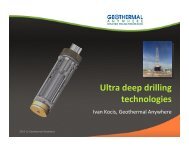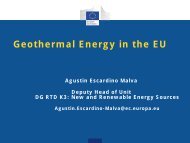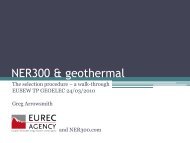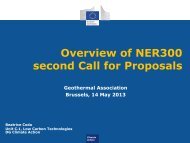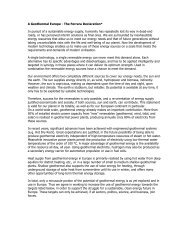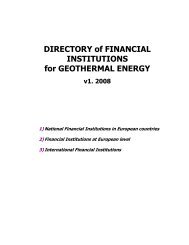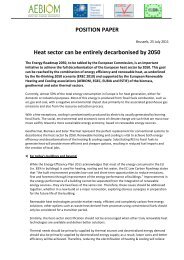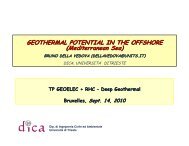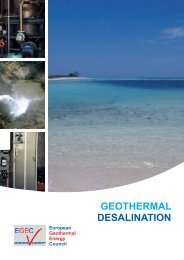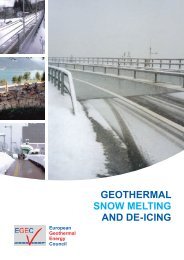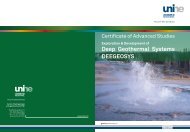Strategic Research and Innovation Agenda for Renewable ... - EGEC
Strategic Research and Innovation Agenda for Renewable ... - EGEC
Strategic Research and Innovation Agenda for Renewable ... - EGEC
Create successful ePaper yourself
Turn your PDF publications into a flip-book with our unique Google optimized e-Paper software.
7<strong>Strategic</strong> <strong>Research</strong> <strong>and</strong> <strong>Innovation</strong> <strong>Agenda</strong> <strong>for</strong> <strong>Renewable</strong> Heating & CoolingEnabling technology<strong>Renewable</strong>Heating & CoolingEuropean Technology Plat<strong>for</strong>mThis chapter looks at two key areas to enable the achievement of the full potential of RHC: bydeveloping targeted ICT support tools, <strong>and</strong> through research in materials science.7.1 In<strong>for</strong>mation <strong>and</strong> CommunicationTechnology (ICT)As heating <strong>and</strong> cooling technologies become more intelligent, the flexibility availableto the energy system is increased <strong>and</strong> the associated costs lowered. In<strong>for</strong>mation <strong>and</strong> CommunicationTechnology (ICT) plays an increasing role in reducing the energy intensity of ourapplications, there<strong>for</strong>e enabling renewable heating <strong>and</strong> cooling systems to satisfya higher share of the energy dem<strong>and</strong>.By monitoring <strong>and</strong> directly managing energy consumption, ICT can enable efficiencyimprovements in all applications which require a thermal energy supply. Some studiessuggest that this capacity can be exploited to reduce energy consumption of buildings in theEU by up to 17%. 74 ICT can also address the complexity of measuring energy per<strong>for</strong>manceat a system level 75 : Software tools can provide in<strong>for</strong>mation <strong>and</strong> data on howto better configure the various elements of a system so as to optimise its overall energyper<strong>for</strong>mance in a cost-effective manner. Applications of these ICT tools spread from smallerto more complex, large-scale systems such as urban areas <strong>and</strong> cities.ICT developments enabling advancements in controls <strong>and</strong> per<strong>for</strong>manceassessment of RHC systemsWithin the next decade, heating <strong>and</strong> cooling systems will become increasingly integrated.Smarter meters will be at the centre of the integrated solutions, including interaction withother networks (ICT, electricity, water, etc.). Smart meters are expected to facilitate this interactionby collecting data from all the different networks. At the same time, users <strong>and</strong>installers will dem<strong>and</strong> that the interaction with technology is simplified. This requires largeadvancements in design monitoring, control, per<strong>for</strong>mance analysis, remote maintenance,output control, <strong>and</strong> certification of heating <strong>and</strong> cooling systems. In<strong>for</strong>mation should be madeavailable in different <strong>for</strong>ms <strong>and</strong> different levels of detail to multiple communities; operators<strong>and</strong> utilities require accurate technical data to control their systems, while consumers needto be in<strong>for</strong>med about their energy consumption, the available energy sources <strong>and</strong> the relatedcosts. Such in<strong>for</strong>mation should be presented in an easy <strong>and</strong> intuitive <strong>for</strong>m allowing nonspecialists to make in<strong>for</strong>med choices. All these improvements will need to be highly reliablewithout significantly increasing the total cost of the systemsAll newly introduced energy subsystems require supervision to underst<strong>and</strong> <strong>and</strong> assess theper<strong>for</strong>mance of the overall system. Biomass unit operation should be optimised through theapplication of fuel quality monitoring <strong>and</strong> on-line process monitoring; new on-linesensors <strong>and</strong> dashboards are required to monitor combustion units <strong>and</strong> their integration withother components (from energy storage to the heating <strong>and</strong> cooling distribution network).Different types of combustion process models should be developed <strong>and</strong> validated based ona common methodology.74[GeSI 2008] Bio IntelligenceImpacts of In<strong>for</strong>mation <strong>and</strong>Communication Technologieson Energy Efficiency. Smart2020 Enabling the low-carboneconomy in the in<strong>for</strong>mationage.75For consistency with thewording of the EuropeanCommission [EC 2009] -COM(111), in this contexta system consists of manyenergy consuming entities.Examples include datacentres, buildings, factories<strong>and</strong> cities.There is the need to work on advanced control algorithms <strong>and</strong> integration into wholeHVAC system controls, which are necessary to improve per<strong>for</strong>mance. These advancedalgorithms can also relate to design per<strong>for</strong>mance validation, or to advanced online per<strong>for</strong>mancecontrol <strong>and</strong> maintenance activities. Furthermore, installation cost reductions <strong>and</strong> controlsystems’ operation are important aspects to be improved.Accurate <strong>and</strong> pervasive monitoring is also a key element to per<strong>for</strong>m predictive <strong>and</strong>optimized maintenance. For solar thermal technology, by analysing the behaviour of systemsoperating under particular conditions, it is possible to quickly detect possible malfunctioning<strong>and</strong> to alert the end-user or service company. The per<strong>for</strong>mance guarantee of solar thermalsystems is expected to improve thanks to technical progress <strong>and</strong> ICT development.73



